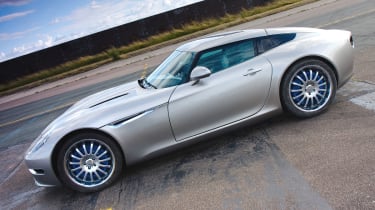Lightning strikes: Electric Special: Lightning
As the 644bhp electric-powered Lightning is driven for first time, we talk to the company about the journey so far – and the challenges ahead
July 20, 2008; three days before the opening of the British motor show. A small crowd has gathered at RAF Alconbury in Cambridgeshire to witness the Lightning turn a wheel in anger for the first (and so far only) time. It does so quietly – the in-wheel electric motors powered by nano-titanate batteries are quieter than any internal combustion engine – but any sound is drowned by a huge cheer. It moves, it works. Mission accomplished. Stage one complete.
‘Stage one,’ says managing director Chris Dell later, ‘was getting to the motor show with a car that had been demonstrated to work. Almost 20 people drove it that day. I wanted all who had had anything to do with the car to be able to say they were one of the first. I drove it last. We needed to show it had commenced testing otherwise people would simply think it was a concept car.
‘It was the right decision but one that put the team under tremendous pressure,’ Dell continues. ‘We were installing the car at 3am on the morning of the show having had only six hours’ sleep in three days.
‘Next we’re into stage two, refining and developing, and finally stage three, commercialising it.’Dell isn’t your typical British sports car company boss. Direct and confident, he talks aims, plans and targets – a legacy of his background in corporate marketing. You get the impression that he brings business nous to the project.
The engineering acumen comes from technical director Arthur Wolstenholme. Past credits include a Vanwall replica and, more crucially, the Ronart Lightning, a traditional V8 sports coupe launched at the 1999 British motor show. Google it and spot the similarities to the car here…Project Lightning came about when Wolstenholme was looking for new power sources for the Ronart. But this is not a matter of taking an existing sports car and simply converting it to run on electricity. ‘The only carry-over part is the windscreen,’ Wolstenholme tells me, ‘everything else – chassis, interior, bodywork – is new.’
The styling is the work of Transport Design graduate Daniel Durrant, now, like the rest of the team, a permanent employee of the Lightning Car Company. It’s a handsome device. Conventional, traditional but with enough of a twist to keep the eye interested. It looked great under show lighting, but more importantly the lines don’t shed their appeal as we wheel it out onto the street in front of the Clive Sutton showroom next door to Lord’s Cricket Ground.
This car’s not for sale, though, nor has this venue been chosen simply because it’s on neutral territory for all parties. Instead the prototype is on an extra promotional tour before stage two gets fully underway. It looks settled here, at ease and surprisingly finished. They’re hoping to switch to frameless doors, but the cabin is at least 90 per cent there – right down to the slick action of the control knobs and a level of detail that includes pedals machined with ‘+’ (throttle) and ‘–’ (brake) symbols.
The speed at which this has all happened is remarkable – just nine months from basic sketch to finished car. In that time Durrant has been responsible for every single detail, right down to the placing of the stitching on the seat. It’s a hell of an achievement. He smiles ruefully before saying, ‘My wife hasn’t seen much of me for the last nine months.’
We have a good poke around. The boot is enormous, the driving position comfortable, headroom good, the layout clear and simple, the view forward dominated by the high bonnet. The ‘engine’ bay is the only place that’s off limits – they don’t want to reveal too much of the technology. You get the feeling that relationships between Lightning and its supplier partners are crucial – and the two key relationships are with PML Flightlink and Altair Nano, the British electric motor firm and the American battery producer respectively.
Unlike the Tesla Roadster, which uses conventional lithium-ion batteries, the Lightning is powered by nano-titanate cells equivalent to the size and weight of about 30 car batteries. According to Wolstenholme the advantages are ‘a much wider operating temperature, from -25 to +75 deg C, a 12-year life expectancy with no deterioration, and very little friction in the cell structure.’ As a result the cell-packs front and rear don’t need additional heating and cooling like the Tesla’s, and as the batteries charge-up the temperature within them actually drops. ‘When it first happened in the lab we thought the gauges had bust!’ says technical project manager John Paterson.
But what does this mean? Well, with a target kerb weight of 1450kg and top speed limited to 130mph to preserve energy, a 200-mile range is on the cards. Charging up from empty should take 12 hours on a normal three-pin supply. ‘But on a three-phase industrial supply, the kind most business premises have, a full charge will take just ten minutes,’ adds Wolstenholme. This technology is beginning to creep onto garage forecourts – just think of it, a full charge in little more time than it takes to refill with petrol.
But in order to get to that stage, Lightning needs to overcome issues surrounding the in-wheel motors. These develop 120kW (equivalent to 161bhp) each, but their positioning in the wheel exposes them to all the forces that act on unsprung weight.
How can the car’s wheels cope with an extra 25kg a corner? ‘They don’t have to,’ Paterson tells me, ‘the motors bolt straight on to the suspension upright and take the place of the heavy duty hub, bearings, driveshaft, brake disc and caliper. As a result we only weigh about 3kg more per corner than a conventional set-up.’
The motors have been developed exclusively for automotive use and have already been seen on the Volvo ReCharge Concept. Also responsible for the car’s braking, they deliver regenerated energy back into the batteries and, because the power is produced at the wheels, there are no transmission losses, so all 644bhp goes straight to the road. No wonder a 4sec 0-60mph is predicted.
The motors are controlled by a central management unit that PML Flightlink is responsible for. This is the really trick bit because every motor is totally independent, so needs to respond differently to bends, where all the wheels will be transcribing different arcs. As Wolstenholme points out: ‘It’s a big challenge, but they’re infinitely controllable. If you wanted to sit there in a cloud of smoke with the front wheels spinning forwards and the rears backwards, it could be done.’
Developing the technology will take at least another nine months, after which the car will go into production, built by two separate suppliers in Coventry. Maximum annual capacity is 500 units. ‘Although in the long term we’d really hope to construct the car ourselves,’ says Dell. The current glass-carbon composite for the body will give way to superformed aluminium, and first owners (deposits for the £120,000 car are ‘into three figures’) should take delivery towards the end of next year.
What’s interesting about the Lightning is that, like the Tesla, it forces us to recalibrate everything we know and understand about sports cars. No longer is packaging dictated by the engine and fuel tank, while power is delivered to the wheels in an entirely new way. Is the Tesla a rival? Chris Dell is unequivocal: ‘As far as we see it, we’re all in this together, and the more electric cars that are out there taking this process forward, the better.’ Lightning aims to be at the forefront. Plans for another two models are in the pipeline and we could see early ideas for ‘an upmarket four- or five-seater’ before Christmas.
What’s needed is further investment, but right now Lightning’s vital signs are good. Stage Two beckons.




